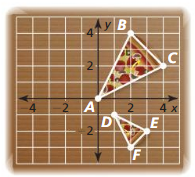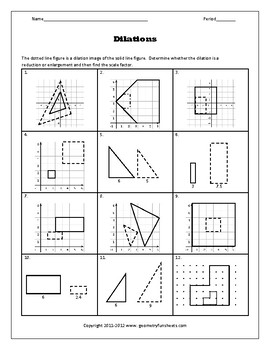
Check answer key and turn in when you're finished. Which composition of similarity transformations maps polygon ABCD to polygon ABCD O a dilation with a scale factor of and then a rotation O a dilation. In-Class Activity: Complete the exercises 9-14 on pg 219.

Triangle KLJ is mapped to triangle NPM by a similarity transformation therefore they're similar. A similarity transformation maps a circle of radius R to a circle of radius rR, where r is the scale factor of the similarity transformation. A dilation centered at point P with a scale factor of k = v/t maps point K to point N and point J to point M. Learning Check: Triangle KLJ is similar to triangle NPM iff there is a similarity transformation that maps one onto the other. A similarity transformation is when a figure is transformed into another through enlargement or reduction in size. note Key Concept Similar Figures Two figures are similar if and only if there is a similarity transformation that maps one figu onto the other. Less obviously, there are also conformal maps which are not similarity transformations see Figure 2.1. A similarity transformations maps square ABCD to square EFGH therefore they are similar. Similarity transformations: Compositions of rigid motions and dilations map preimages to similar images. Angle measures are preserved in all transformations. similarity transformations in Rn which are the composition of a rotation, a translation and. Now, in the dual space, orthogonal transformations map. Then a dilation centered at point E with a scale factor of k=2 maps point B to point F, point C to point G, and point D to point H. Any similarity transformation of Euclidean space can be obtained as a composition of four basic. X 6.2 Similar Triangle Theorems 7.B 2 This lesson explores the Angle-Angle Similarity Theorem, Side-Angle-Side Similarity Theorem, and Side-Side-Side Similarity Theorem.

Students also use multiple dilations to determine images and pre-images. Recall that square ABCD is similar to square EFGH iff there is a similarity transformation that maps one onto the other. They will also use transformations to map one triangle to another triangle. Check answer key and turn in when you're finish. If point X (x, y) is dissolved by factor k, the new position is X ‘(kx, ky).In-Class Activity: Complete exercises 3 – 6 on page 219. The types of transformations are reflection, rotation, translation and dilation.ĭigestion is a type of transformation that increases or decreases an object and thus produces an image that has the same shape but a different size to the object. Transformation involves the movement of a point from its starting position to a new location. Which composition of similarity transformations maps polygon ABCD to polygon A'B'C'D' a dilation with a scale factor of and then a rotation a dilation with a scale. Hence any similarity transformation is a composition of a dilation followed by an. Since the polygon vertices ABCD are at A (-3, 3), B (5, 3), C (5, -1), D (1, -5) and the polygon vertices are A’B’C ‘A’ has D ‘(- 5, -2), B’ (- 3, 2), C ‘(- 3, -3), D (-4, -4) Overview of Section 5.4 Similarity transformations and constructions. A similarity transformation is a composition of rigid motions and/or dilations Two figures.

#WHICH COMPOSITION OF SIMILARITY TRANSFORMATIONS MAPS SERIES#
O a dilation with a scale factor of 4 and then aĭilation with scale factor 4 and then translation What is the series of transformations to bring RST to PYZ. O a dilation with a scale factor of 4 and then a rotation


 0 kommentar(er)
0 kommentar(er)
